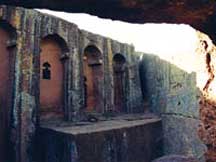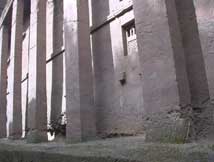Constructed in the 16th century, these 11 churches continue to attract and intrigue countless visitors to this day. Their unique architecture is so extraordinary that even the creators themselves may have doubted whether people would believe in what they built.
|
|
Inside the churches, the massive monolithic stones used for construction remain intact. Scientists are still puzzled about how people in the 13th century transported these stones from the surrounding mountains to the construction site. | |
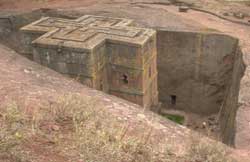 | 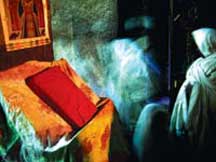 |
Unique and sacred – these are the words visitors often leave after visiting this ancient cross. With a structure entirely made of stone, built nearly 5 meters below ground level, it is now a holy land for the people of Lalibela. | Lalibela parishioners attending service in a rock-hewn church |
The Land of Rock-Hewn Churches
Lalibela is one of the cities of the Amhara people, also known as Kilil, in Ethiopia. Located at an elevation of 2,500 meters above sea level at 12.04 degrees North and 39.04 degrees East, it has a current population of approximately 8,484 people. Lalibela is a center for pilgrimage.
This city features churches constructed from monolithic rock during the reign of Saint Lalibela (a member of the Zagwe dynasty), who ruled over all of Ethiopia in the 13th century. There are 11 ancient churches in the city, divided into three groups. The northernmost group includes the Bete Medhane Alem church, the largest rock-hewn church in the world, possibly modeled after the Church of Saint Ary in Aksum, another region in Ethiopia. The westernmost group features the Bete Giyorgis church, which is preserved almost intact, while the easternmost group consists of four churches designated for royalty, among which the Bete Gabriel-Rufael church is known for producing the oldest communion bread (from wheat flour) in the world.
The first Europeans to discover these churches were the Portuguese explorer Pêro da Civilhã (1460 – 1562). However, the Portuguese priest Francisco Alvares (1465 – 1540) is credited with one of the earliest accounts of Lalibela, having accompanied a Portuguese ambassador on a visit to Lebna Dengel in the 1520s.
A Masterpiece by an Anonymous Architect
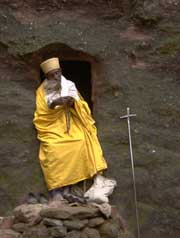 |
A priest inside the church |
The churches are entirely carved from volcanic rock. Initially, deep trenches were dug around the large rock formations on the mountainside to separate them from the mountain. Then, starting from the top and working downwards, stone was excavated meter by meter from the volcanic rock, creating rock-hewn churches with domed ceilings, windows, corridors, and large doorways. Inside, aside from stone columns supporting the ceiling and archways, everything else is hollowed out.
The churches are robust and spacious. The Church of the Savior measures 33.5 meters long, 23.5 meters wide, and 10.6 meters high. The Sainte Maria church features windows in the shape of Latin crosses and ancient Greek designs, including swastikas and circular crosses. The central stone column in the church is wrapped in fabric.
The churches are interconnected by volcanic rock pathways resembling a maze. The large block of volcanic rock forming the Saint Georges church is intricately carved with a cross. Saint Georges is located in a very deep volcanic chamber, with underground passages leading to the entrance, commemorating the heroic efforts and extraordinary determination of those who constructed the churches.
Architectural studies of the churches in Ethiopia reveal two primary influences: first, they were constructed in the Axumite architectural style, characterized by the use of monolithic stone and wood for the central columns; second, they follow the deep building style of Roman churches, which often feature two rows of columns. These churches reflect the prominent Axumite architectural tradition and ancient Mediterranean Christian influences: they represent a new creative expression of religious art in Ethiopian soil.
In 1978, Lalibela was recognized as a World Heritage Site by the United Nations Educational, Scientific and Cultural Organization (UNESCO).
Tran Ngoc Phuc








































